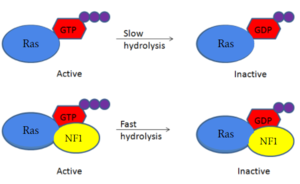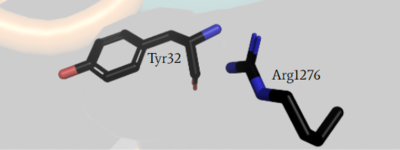Sandbox Reserved 1706
From Proteopedia
(Difference between revisions)
| Line 12: | Line 12: | ||
Neurofibromin is a [https://en.wikipedia.org/wiki/GTPase-activating_protein GTPase-activating protein] that binds to [https://en.wikipedia.org/wiki/Ras_GTPase Ras], a [https://en.wikipedia.org/wiki/GTPase GTPase], to increase its inherent hydrolysis of GTP to GDP (Figure 1). This inactivates the cell signaling of Ras until reactivated by [https://en.wikipedia.org/wiki/Guanosine_triphosphate GTP] exchange. Neurofibromin has two structural conformations, the open and closed conformation. Neurofibromin only binds to Ras in its open conformation. <ref name="Bourne"> DOI:10.1038/39470</ref><ref name="Lupton"> DOI:10.1038/s41594-021-00687-2</ref><ref name="Naschberger"> DOI:10.1038/s41586-021-04024-x</ref> [[Image:RasNeurofibrominMech.PNG|300px|right|thumb|Figure 1: Shifted rate of of Ras GTP hydrolysis when bound to neurofibromin. The speed of GTP hydrolysis is significantly increased when bound to neurofibromin. Ras is inactive when bound to GDP and active when bound to GTP ]] | Neurofibromin is a [https://en.wikipedia.org/wiki/GTPase-activating_protein GTPase-activating protein] that binds to [https://en.wikipedia.org/wiki/Ras_GTPase Ras], a [https://en.wikipedia.org/wiki/GTPase GTPase], to increase its inherent hydrolysis of GTP to GDP (Figure 1). This inactivates the cell signaling of Ras until reactivated by [https://en.wikipedia.org/wiki/Guanosine_triphosphate GTP] exchange. Neurofibromin has two structural conformations, the open and closed conformation. Neurofibromin only binds to Ras in its open conformation. <ref name="Bourne"> DOI:10.1038/39470</ref><ref name="Lupton"> DOI:10.1038/s41594-021-00687-2</ref><ref name="Naschberger"> DOI:10.1038/s41586-021-04024-x</ref> [[Image:RasNeurofibrominMech.PNG|300px|right|thumb|Figure 1: Shifted rate of of Ras GTP hydrolysis when bound to neurofibromin. The speed of GTP hydrolysis is significantly increased when bound to neurofibromin. Ras is inactive when bound to GDP and active when bound to GTP ]] | ||
==Structure== | ==Structure== | ||
| + | Neurofibromin is a [https://en.wikipedia.org/wiki/Protein_dimer protein dimer] that exists in closed<scene name='90/904311/Closed_conformation/3'>closed</scene> and <scene name='90/904311/Open_conformation/2'>open</scene> conformations. The exact initiation of structural rearrangement is currently unknown and a point of further research. DOI:10.1038/39470</ref><ref name="Lupton"> DOI:10.1038/s41594-021-00687-2</ref><ref name="Naschberger"> DOI:10.1038/s41586-021-04024-x</ref>. Both protomers contain 5 separate domains. | ||
===Domains=== | ===Domains=== | ||
[[Image:Domain.PNG|500px|right|thumb|Figure 2: Domains for NF1 and the pertinent colors. Numerical values show domain locations along the polypeptide chain.]] | [[Image:Domain.PNG|500px|right|thumb|Figure 2: Domains for NF1 and the pertinent colors. Numerical values show domain locations along the polypeptide chain.]] | ||
====N-C HEAT ARM==== | ====N-C HEAT ARM==== | ||
| - | + | The first domain are two separate but very similar domains; the N-HEAT ARM(N-Terminal) and C-HEAT ARM(C-Terminal). [https://en.wikipedia.org/wiki/HEAT_repeat HEAT] and [https://en.wikipedia.org/wiki/Armadillo_repeat ARM] are acronyms for a repeating structure of helices. Structurally, the N-HEAT ARMs consist of various helices and loops that interconnect on one of the existing protomers. The N-HEAT ARM is critical in stabilization and linking the catalytic and core domains. The N-HEAT ARM in its linkage with the GRD catalytic domain also has a direct impact on the relative conformational change from the active (Ras BOUND) to inactive (Ras unbound) states. The Zn2+ binding site also extends from the N-HEAT ARM just before the GRD and SEC14-PH domains. The C-HEAT Arm plays similar roles to the N-HEAT ARM by stabilizing and linking the GRD and SEC14-PH domain and contributing to the conformational changes from the closed to open state.<ref name="Lupton"> DOI:10.1038/s41594-021-00687-2</ref><ref name="Naschberger"> DOI:10.1038/s41586-021-04024-x</ref> | |
====GRD==== | ====GRD==== | ||
Neurofibromin’s main catalytic domain is the GRD active site. Linked structurally to both HEAT ARM’s, it consists of mainly loops and helices. There is one single GRD binding site per protomer. In the closed state, Ras cannot bind the GRD site due to a steric hindrance in which Ras clashes with the N-HEAT ARM. Within the GRD site, the critical active site residue is Arg1276.<ref name="Lupton"> DOI:10.1038/s41594-021-00687-2</ref><ref name="Naschberger"> DOI:10.1038/s41586-021-04024-x</ref> | Neurofibromin’s main catalytic domain is the GRD active site. Linked structurally to both HEAT ARM’s, it consists of mainly loops and helices. There is one single GRD binding site per protomer. In the closed state, Ras cannot bind the GRD site due to a steric hindrance in which Ras clashes with the N-HEAT ARM. Within the GRD site, the critical active site residue is Arg1276.<ref name="Lupton"> DOI:10.1038/s41594-021-00687-2</ref><ref name="Naschberger"> DOI:10.1038/s41586-021-04024-x</ref> | ||
| Line 23: | Line 24: | ||
The Sec14-PH domain is linked and extends out from the HEAT ARM’s. Sec14-PH functions as a membrane associated domain and using a hydrophobic cavity binds to neurofibromin the plasma membrane. The <scene name='90/904311/Closed_conformation/3'>closed conformation</scene> also blocks Sec14-PH binding to the cell membrane due to blocking by GRD. <ref name="Lupton"> DOI:10.1038/s41594-021-00687-2</ref><ref name="Naschberger"> DOI:10.1038/s41586-021-04024-x</ref> | The Sec14-PH domain is linked and extends out from the HEAT ARM’s. Sec14-PH functions as a membrane associated domain and using a hydrophobic cavity binds to neurofibromin the plasma membrane. The <scene name='90/904311/Closed_conformation/3'>closed conformation</scene> also blocks Sec14-PH binding to the cell membrane due to blocking by GRD. <ref name="Lupton"> DOI:10.1038/s41594-021-00687-2</ref><ref name="Naschberger"> DOI:10.1038/s41586-021-04024-x</ref> | ||
===Conformations=== | ===Conformations=== | ||
| - | Neurofibromin is a [https://en.wikipedia.org/wiki/Protein_dimer protein dimer] that exists in closed<scene name='90/904311/Closed_conformation/3'>closed</scene> and <scene name='90/904311/Open_conformation/2'>open</scene> conformations. The exact initiation of structural rearrangement is currently unknown and a point of further research. DOI:10.1038/39470</ref><ref name="Lupton"> DOI:10.1038/s41594-021-00687-2</ref><ref name="Naschberger"> DOI:10.1038/s41586-021-04024-x</ref> | ||
====Closed conformation==== | ====Closed conformation==== | ||
Ras is unable to bind to the GRD active site when both of the neurofibromin protomers are in the closed conformation. In the <scene name='90/904311/Closed_conformation/3'>closed conformation</scene>, one protomer has its domains shifted by a 130° rotation of three separate conformational change linkers. That rotation places <scene name='90/904311/Closed_arg/4'>Arg1276 in the closed conformation</scene> in an orientation that <scene name='90/904312/Closed_zoom/1'>sterically hinders the binding between Ras and Arg1276</scene> in the GRD site (Figure 3). Ras binding to the GRD site is inhibited by steric occlusion from the N-HEAT ARM. The <scene name='90/904311/Closed_conformation/3'>closed conformation</scene> can exist naturally without any form of stabilization but exists in a natural equilibrium with the <scene name='90/904311/Open_conformation/2'>open conformation</scene>.<ref name="Bourne"> DOI:10.1038/39470</ref> <ref name="Lupton"> DOI:10.1038/s41594-021-00687-2</ref><ref name="Naschberger"> DOI:10.1038/s41586-021-04024-x</ref> | Ras is unable to bind to the GRD active site when both of the neurofibromin protomers are in the closed conformation. In the <scene name='90/904311/Closed_conformation/3'>closed conformation</scene>, one protomer has its domains shifted by a 130° rotation of three separate conformational change linkers. That rotation places <scene name='90/904311/Closed_arg/4'>Arg1276 in the closed conformation</scene> in an orientation that <scene name='90/904312/Closed_zoom/1'>sterically hinders the binding between Ras and Arg1276</scene> in the GRD site (Figure 3). Ras binding to the GRD site is inhibited by steric occlusion from the N-HEAT ARM. The <scene name='90/904311/Closed_conformation/3'>closed conformation</scene> can exist naturally without any form of stabilization but exists in a natural equilibrium with the <scene name='90/904311/Open_conformation/2'>open conformation</scene>.<ref name="Bourne"> DOI:10.1038/39470</ref> <ref name="Lupton"> DOI:10.1038/s41594-021-00687-2</ref><ref name="Naschberger"> DOI:10.1038/s41586-021-04024-x</ref> | ||
Revision as of 00:28, 19 April 2022
| This Sandbox is Reserved from February 28 through September 1, 2022 for use in the course CH462 Biochemistry II taught by R. Jeremy Johnson at the Butler University, Indianapolis, USA. This reservation includes Sandbox Reserved 1700 through Sandbox Reserved 1729. |
To get started:
More help: Help:Editing |
Neurofibromin 1
| |||||||||||





